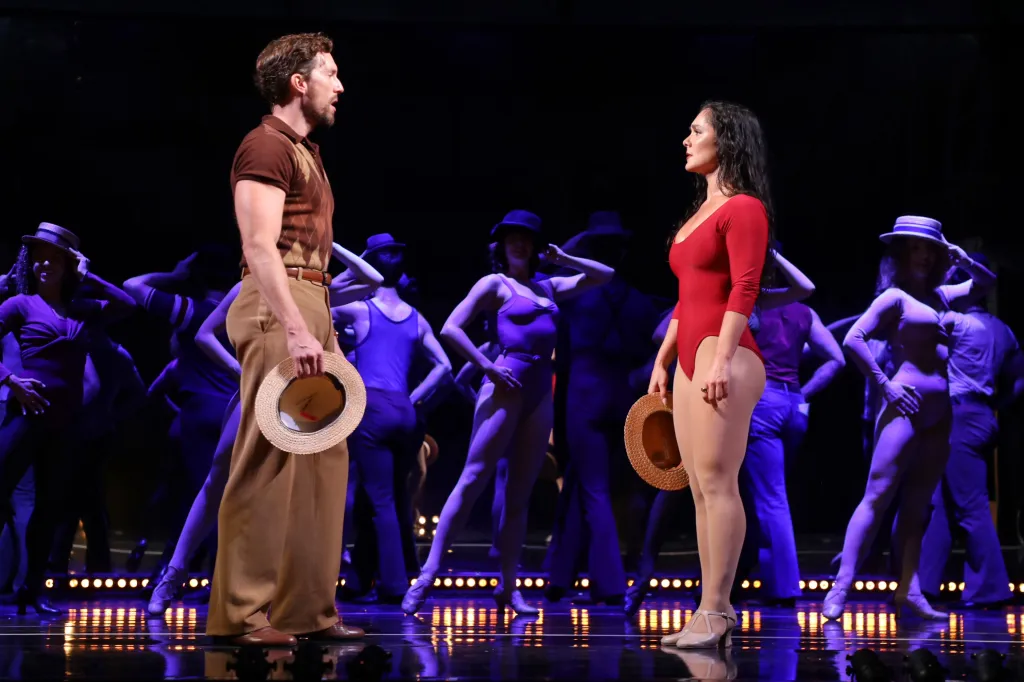
Goodspeed Musicals is dedicated not only to staging great American musicals but studying them, building upon them and figuring out what makes them tick. That’s what makes the theater’s new production of the 50-year-old classic “A Chorus Line” so special.
There’s no nostalgia in it. The songs, from “What I Did for Love” to “One” aren’t greatest hits you’re waiting to hear. They’re a part of the show’s plot and dialogue and feel and tone and atmosphere. The characters matter. So does the time period: New York City when Broadway was troubled and Times Square hadn’t yet been Disneyfied.
This production has an unsettled eerie vibe which works beautifully for its tale of worried dancers experiencing a high-tension audition for a new show.
Unless you count the ones it world-premiered back then which went on to Broadway, such as “Annie” and “Shenandoah,” the Goodspeed Opera House hasn’t done a whole lot of musicals from the 1970s. A couple of Stephen Sondheims, “Pippin,” “1776,” “Mack & Mabel” and that’s about it — and you have to go back over 20 years to have seen some of those there. There actually seems to be better representation of the ‘80s at Goodspeed than the ‘70s, which makes a Goodspeed production of “A Chorus Line” — the biggest musical success of the 1970s, not to mention one of the longest running Broadway musicals of all time — a bigger deal than just “Hey, cool show, about time.”
All the ‘70s shows named above take place in times other than the 1970s. The culture of the time when a show was written is a challenge for any production. In this case, there’s some sexism, racism, classism, antiquated views of gender roles and gender identity and other bits which, while they don’t upend or unbalance the show overmuch, defy any opportunity to update or contemporize it.
So many non-New York productions of “A Chorus Line” fail from the get-go for two big reasons: They don’t capture the essential 1970s New York City vibe of the show and/or you simply don’t believe that the performers are good enough to even audition for a Broadway show let alone be in one. Unlike most other regional theaters, the Goodspeed’s dedication to American musical theater and its proximity to NYC means that most of the performers in most of its shows have Broadway credits. Many of them have been in exactly the same position as the characters in “A Chorus Line,” which famously was based on taped interviews which the show’s chief creator, director/choreographer Michael Bennett, conducted with Broadway dancers he knew.
Starting with Bennett himself, “A Chorus Line” has usually been entrusted to double-threat director/choreographers. The Goodspeed splits the responsibilities. Rob Ruggiero (the TheaterWorks Hartford honcho who’s now done over a dozen shows for Goodspeed and also regularly directs at another major U.S. musical-driven theater, the Muny in St. Louis, Missouri) campaigned for the directing gig but insisted on bringing in his frequent collaborator Parker Esse. Their shared sense of purpose is a revelation: Ruggiero handles the tension and suspense and drama, while Esse makes the dancing spectacular. This production reminds you how much opportunity for great dancing there is in “A Chorus Line” if the cast is as uniformly into it as this one is.
Between Ruggiero and Esse no movement is wasted. Scenes when the auditioners are being taught a routine are as fascinating to watch as the much more refined dances. As they dance, you see the characters checking each other out enviously or competitively, exhibiting their own shortcomings and creating bonds with each other.
We slowly then suddenly get to know the characters. The auditioners enter with attitudes and mannerisms already embedded in them. Then Zach insists they reveal themselves through blunt interviews and monologues conducted in front of the rest of the group.
This “A Chorus Line” is staged firmly in the 1970s and does not try to shift the show to the present day or set it in some timeless generic backstage universe. Joseph Shrope’s costume design is brilliant in this respect. The costumes aren’t ostentatious about being from the ‘70s, though they are true to the era. They look comfortable and well-worn and they fit the personalities of the performers who dance in them.
Shrope is also responsible for jazzing up the finale for “A Chorus Line,” which was snazzy and spectacular in its time but has become trite and predictable over the years. At the Goodspeed, Shrope’s loose and groovy yet still sparkly outfits, plus Ruggiero’s decision to turn the closing number into a lengthy, character-driven curtain call, adds depth and humanity to the final minutes of the show.
One thing any production of “A Chorus Line” has to deal with nowadays is that the show hasn’t been “one singular sensation” itself for a very long time. When it first happened, “A Chorus Line” was praised for its frank discussions of sex, sexual abuse, homosexuality, body image, drug use, alcoholism and other realities shared by its characters. Today such confessional scenes are commonplace. More than that, some of the specific revelations in “A Chorus Line” now come off as sexist, classist, underwhelming, overwrought or weirdly out of touch. Many of the secrets shared by the hopeful castmates are still effective and can tear your heart out, but others may make you wince. Since some of these scenes are overwritten, they can get overacted as well, but these are blips in a production that is trying very hard to be naturalistic and emotionally honest, and that’s not something you can usually say about a glitzy Broadway-style Goodspeed Opera House show.
Goodspeed’s ‘A Chorus Line’ to honor 50th anniversary of legendary musical with nod to its creator
There is a sweet subtlety to the musical’s script by James Kirkwood and Nicholas Dante. For almost half of the two-hour show you don’t know who the key characters will be and whose personal stories will rise to the forefront. The Goodspeed cast is particularly good at not upstaging each other until it is their moment to shine. Karli Dinardo is wonderfully subdued as Cassie, the dancer who it’s felt is lowering herself to audition for a chorus line role again after spending time in Hollywood. Diega Guevera in the pivotal role of Paul, whose talk with Zach goes from interview to confessional to therapeutic to near-breakdown level, is just one of many performers in this show who convince you that one can dance divinely and follow everything a director or choreographer tells them with unbelievable precision yet still be wracked with self-doubt, insecurity and extreme anxiety.
As the dominating director Zach, Clifton Samuels (who was part of a major national tour following the 2006 Broadway revival of “A Chorus Line”) affects a flat tone and an unnervingly unemotional approach that suits this mercurial character. He’s another that keeps you guessing, keeps you involved and keeps you entertained in the Goodspeed’s triumphant, heart wrenching “A Chorus Line.”
The central question “A Chorus Line” still asks is “What will you do when you can’t dance anymore?” This carefully controlled production not only asserts the importance of that question, it dramatizes the tragedy of those who can’t dance anymore by fully expressing the marvels wrought by those who can.



